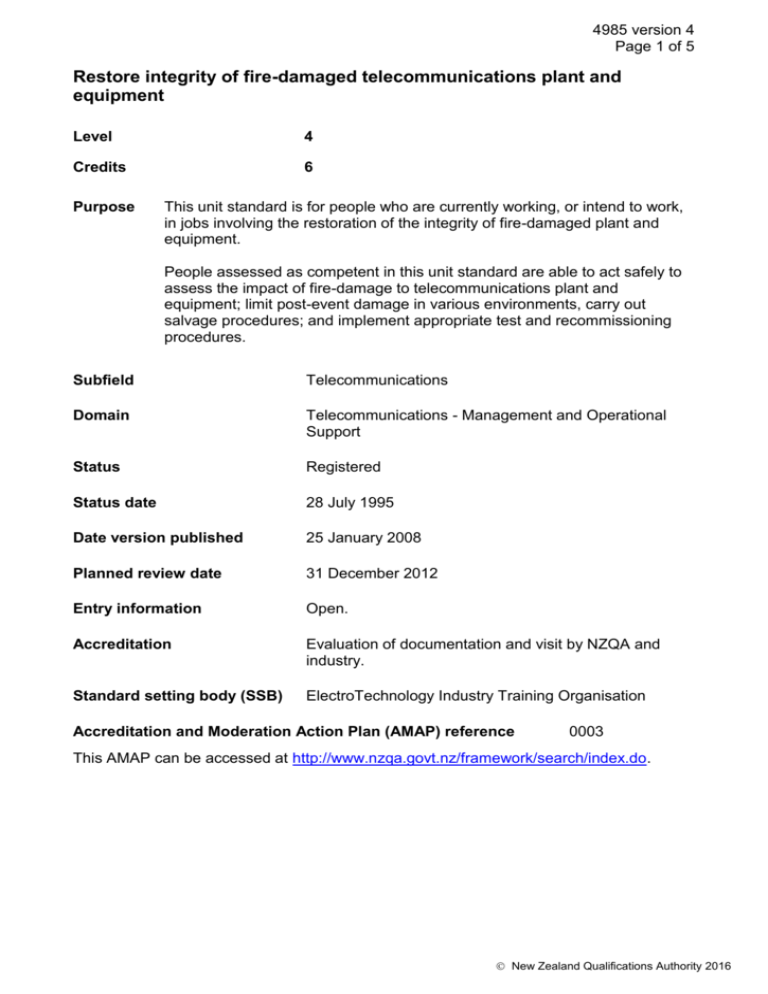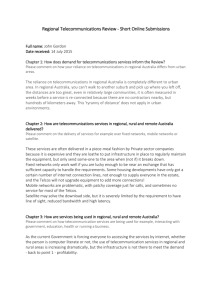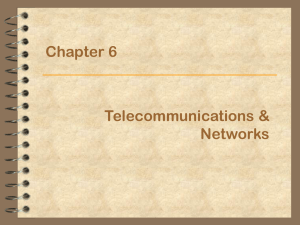4985 Restore integrity of fire-damaged telecommunications
advertisement

4985 version 4 Page 1 of 5 Restore integrity of fire-damaged telecommunications plant and equipment Level 4 Credits 6 Purpose This unit standard is for people who are currently working, or intend to work, in jobs involving the restoration of the integrity of fire-damaged plant and equipment. People assessed as competent in this unit standard are able to act safely to assess the impact of fire-damage to telecommunications plant and equipment; limit post-event damage in various environments, carry out salvage procedures; and implement appropriate test and recommissioning procedures. Subfield Telecommunications Domain Telecommunications - Management and Operational Support Status Registered Status date 28 July 1995 Date version published 25 January 2008 Planned review date 31 December 2012 Entry information Open. Accreditation Evaluation of documentation and visit by NZQA and industry. Standard setting body (SSB) ElectroTechnology Industry Training Organisation Accreditation and Moderation Action Plan (AMAP) reference 0003 This AMAP can be accessed at http://www.nzqa.govt.nz/framework/search/index.do. New Zealand Qualifications Authority 2016 4985 version 4 Page 2 of 5 Special notes General Range Telecommunications plant: heating, ventilating and air-conditioning systems; Alternating Current and Direct Current power supplies and reticulation systems; standby power plant; Telecommunications equipment: electrical, electronic, cable distribution systems; Telecommunications sites and/or buildings: telephone exchanges, radio stations, roadside equipment cabinets, computer suites, plant rooms. Environments: air-conditioned, mechanically or naturally ventilated; Locations: suburban, rural, hilltop, roadside; Fire-damage: soot, ashes, residues, gases, vapours, water containing contaminants. Elements and performance criteria Element 1 Establish safety of fire-damaged telecommunications plant, equipment, and site. Performance criteria 1.1 Safety of fire-damaged plant, equipment, and site is secured by best means and in a minimum time consistent with personal safety. Range 1.2 Actions to maintain personal protection from hazards are accorded highest priority at all times. Range 1.3 hazards – physical condition of building, fumes, gases, residues, water containing contaminants, damaged electrical wiring and plant, debris; personal protection – protective clothing, hard hats. On-site descriptions of scope of problem and actions taken to establish safety of plant and equipment are accurate and comprehensive and are received at agreed times by authorised persons. Range 1.4 best means – own effort, Fire Brigade, Police, power supply authority, appropriate trade services. descriptions – verbal, radio link, audiotape; scope – safety, degree of damage, assistance and equipment required to deal with problems; agreed times – continuous, hourly, as frequently as required; authorised persons – National Control Network, safety professionals. Plant and equipment is isolated from energy sources in minimum time consistent with personal safety. Range energy sources – live wires, powerboards, switchboards, gas. New Zealand Qualifications Authority 2016 4985 version 4 Page 3 of 5 1.5 Actions to secure plant and equipment from smoke and water contamination are implemented promptly and area of contamination is contained. Range 1.6 actions – smoke removal system, removal of wet objects (chairs, mats), use of squeegees, wet/dry vacuum cleaners, paper towels, plastic sheets; water contamination – corrosion, humidity. Report on establishment of safety of fire-damaged plant, equipment, and site is complete and accurate and received by authorised persons by agreed time. Range authorised persons – National Control Network, incident coordinators, recovery coordinators. Element 2 Evaluate fire-damage to telecommunications plant and equipment. Performance criteria 2.1 On-site evaluation of fire-damage to telecommunications plant and equipment is accurate and comprehensive, and is received by authorised persons in minimum time consistent with personal safety. Range 2.2 Chemical contamination of telecommunications plant and equipment is tested on-site, and results are recorded for immediate consideration by authorised persons and for future information. Range 2.3 chemical contamination – halogens, especially chloride; tests – specific commercial analytic test. Physical extent of fire-damage to telecommunications plant and equipment is assessed on-site, and recorded for immediate consideration by authorised persons and for future information. Range 2.4 authorised persons – National Control Network, controlling officer, safety personnel, incident coordinator, recovery coordinator. quantity, total, partial; components. Initial report of likely future reliability of telecommunications plant and equipment and recommendations for salvage or removal are based on valid evidence, and are received by authorised persons by agreed time. Range salvage – decontaminate, reinstate. New Zealand Qualifications Authority 2016 4985 version 4 Page 4 of 5 Element 3 Salvage, test, and recommission telecommunications plant and equipment. Performance criteria 3.1 Plant and equipment to be salvaged and recommissioned and timeframe for completion of work are identified and agreed with authorised persons. 3.2 Resources required to carry out salvage and testing procedures are identified, agreed with authorised persons, and secured. Range 3.3 professional decontamination personnel and facilities, water, power, lighting, fans, software, hardware; on-site, off-site. Handling procedures to facilitate decontamination and testing of fire-damaged plant and equipment maintain on-site safety. Range take to bits, wash, dry, wrap. 3.4 Unit standards and components to be salvaged are labelled and recorded, and are traceable throughout salvage and reinstallation procedures. 3.5 Testing of reinstated plant and equipment complies with performance standards and specifications. Range standards – electrical, electronic, mechanical, software. 3.6 Reports on effectiveness of decontamination and reinstatement procedures are accurate and complete, and supported by chemical test measurement data. 3.7 Liaison with tradespeople required to restore telecommunications plant and equipment facilitates completion of work in agreed timeframe. Range tradespeople – electricians, carpenters, plumbers, metalworkers. 3.8 Telecommunications plant and equipment are salvaged and recommissioned within agreed budget and timeframe. 3.9 Permanent records of salvage, testing, and recommissioning procedures comply with organisation policy, are accurate and complete, and filed in the correct place. Please note Providers must be accredited by NZQA, or an inter-institutional body with delegated authority for quality assurance, before they can report credits from assessment against unit standards or deliver courses of study leading to that assessment. Industry Training Organisations must be accredited by NZQA before they can register credits from assessment against unit standards. New Zealand Qualifications Authority 2016 4985 version 4 Page 5 of 5 Accredited providers and Industry Training Organisations assessing against unit standards must engage with the moderation system that applies to those standards. Accreditation requirements and an outline of the moderation system that applies to this standard are outlined in the Accreditation and Moderation Action Plan (AMAP). The AMAP also includes useful information about special requirements for organisations wishing to develop education and training programmes, such as minimum qualifications for tutors and assessors, and special resource requirements. Comments on this unit standard Please contact the ElectroTechnology Industry Training Organisation reviewcomments@etito.co.nz if you wish to suggest changes to the content of this unit standard. New Zealand Qualifications Authority 2016




